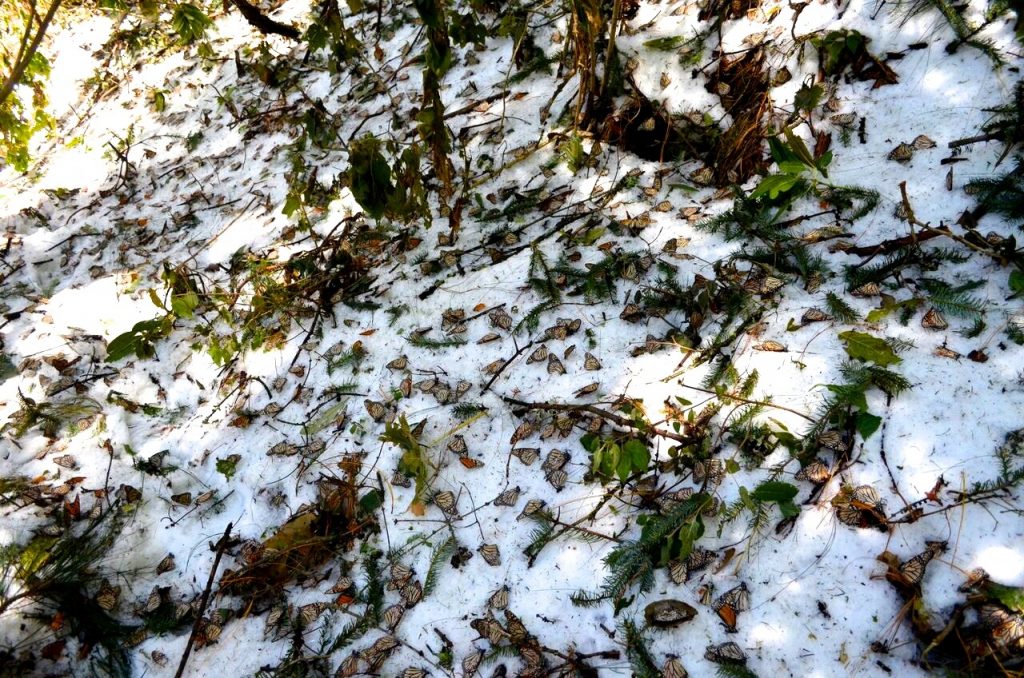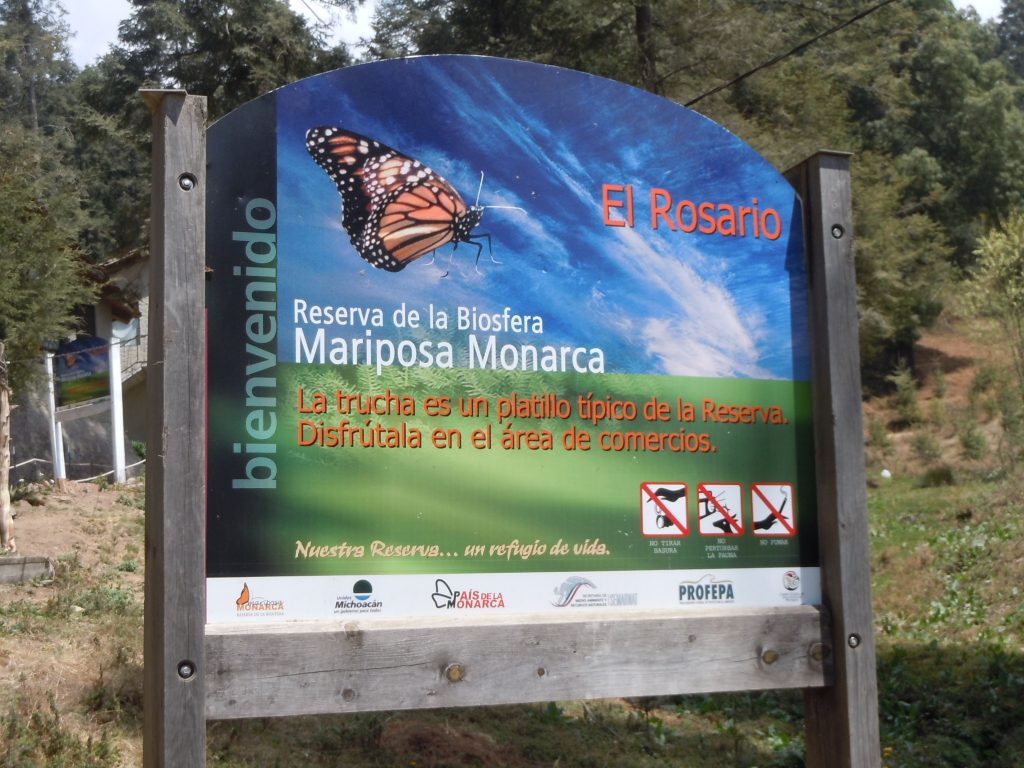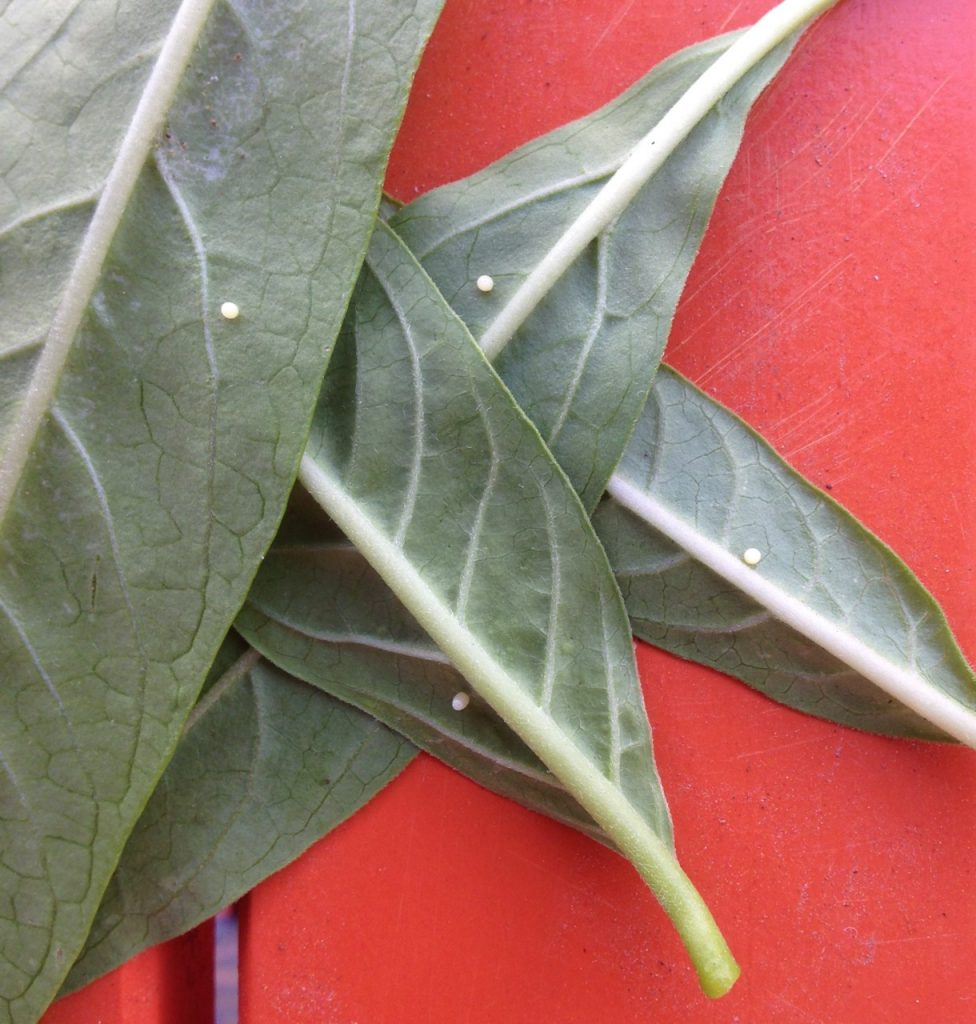Scientists have been scrambling to assess the mortality of the roosting Monarch butterfly population in Michoacán, Mexico, following a freak March 11 winter snowstorm that dropped temperatures to sub freezing and included wind gusts up to 50 miles per hour in the butterflies’ ancestral roosting sites. For now, the estimates of how much of the migrating Monarch butterfly population perished are at best an educated guess.

The scene at Chincua the day after the storm. Photo by Dr. Isabel Ramírez
“I have no new information. We are ‘in limbo,’” said Dr. Chip Taylor, founder of Monarch Watch, the citizen science organization based at the University of Kansas that tags the butterflies each fall to track their migration.
Dr. Lincoln Brower has been working long distance from his home in Sweet Briar, Virginia, with a team of scientists on the ground in the 10,000-foot-tall plus mountains northwest of Mexico City where the butterflies roost each fall. They’ve been gathering data, reviewing climatology information, making observations, and reviewing photos and historical accounts of a previous freeze in 2002.
“It’s been difficult and there are conflicting reports as you know,” said Dr. Brower via email, referring to Mexican tourism officials downplaying the severity of the situation. Soon after news of the storm broke, Mexican officials claimed that only 3% of the butterflies had been affected–about 1.5 million of the estimated 200 million roosting.
“The climate data we have suggest about 50% mortality in Chincua but observations suggest that Rosario was hit harder,” said Brower, referring to the El Rosario sanctuary, the preserve most often visited by tourists. The 50% number would mean 100 million butterflies took the hit–which still leaves us up over last year, just a disappointing and devastating turn of events, if true.

El Rosario Preserve in Michoacán. Photo by Monika Maeckle
Dr. Cuatémoc Sáenz Romero, a forester who studies the Oyamel forest and is promoting an initiative to move it higher in elevation to save it from climate change, thus guaranteeing the Monarchs a future winter roost, said he visited the sanctuaries two weeks after the storm. “Except for some trees fallen, I did not see dramatic damages,” he said.
Many of us are wondering how many of the butterflies had already left the colony when the storm hit on March 11. Typically the first and second week in March are when the Monarchs bust off the Oyamel trees in response to warmer temperatures and begin their journey north. We start to see them moving into South Texas as they search for milkweed on which to lay the first generation of eggs in the multi-generation migration. Some Monarchs have definitely made it to San Antonio and South Texas as we are witnessing and hearing about first-of-season sightings and finding eggs on local milkweeds.

Who’s got Monarch eggs? We do in San Antonio. At least SOME Monarchs escaped the storm. Photo by Monika Maeckle
The question of how many Monarchs departed before the storm hit may be rhetorical, according to one scientist.
“Perhaps that doesn’t even matter given how widespread this storm was,” said Monarch and migration scholar Dr. Tyler Flockhart of the University of Guelph in Ontario. Flockhart said that according to weather data, the winds were so strong that temperatures inside and outside the forest were pretty much the same, suggesting the “butterflies would have been exposed to very cold temperatures.”
Scientists consider the forest canopy as an insulation blanket. As climate change and illegal logging conspire to undermine the forest in the roosting preserves, the unique ecosystem of moisture, temperature and protection from the elements becomes threatened. Several scientists expressed more concern about the huge trees that had been taken by the storm than the mortality of the butterflies, since it will be extremely challenging to recreate the forest canopy in the short-term.
Meanwhile, a study conducted by the Monarch Conservation Science Partnership and released in the journal Scientific Reports March 21 found that the Monarch migration has an 11 to 57 percent chance of facing “quasi-extinction” in the next 20 years.
Dr. John Pleasants, an Iowa State University researcher who participated in the study, defined quasi-extinction to mean that not enough individual Monarch butterflies would exist to continue their migratory patterns. The migration would collapse and the population would likely not recover. That doesn’t mean there will no longer be Monarch butterflies; it does suggest the phenomenon of the unique Monarch butterfly migration would cease to exist if the population falls to even more perilous levels.
We should have more definitive information in the next few weeks as the scientists review the collected data. Stay tuned and keep those fingers crossed.
Related posts:
- At least 1.5 million Monarch butterflies perish in freak Mexican snowstorm
- Good news! Monarch butterfly population triples
- Mighty Monarch butterflies brave south winds, Hurrican Patricia to arrive in Mexico
- Q & A Elizabeth Howard of Journey North talks tech, citizen science, butterfly releases
- Q & A: Catalina Trail, founder of the Monarch butterfly roosting sites
- 2015 a Banner Year? Monarch butterfly migration heading our way
- Q & A: Dr. Lincoln Brower on Endangered Species, Ethics, Milkweed and Monarchs
- How to tag a Monarch butterfly in Six Easy Steps
- Endangered Species Act Wrong Tool for the Job of Monarch Butterfly Conservation?
- Monarch Butterfly Inches Toward “Threatened” Status Under Endangered Species Act
Like what you’re reading? Follow butterfly and native plant news at the Texas Butterfly Ranch. Sign up for email delivery, like us on Facebook, or follow us on Twitter, @monik

I have 30 cats on my milkweed and have had to buy 15 more plants in Houston.
That’s fantastic. I am celebrating having ten in my yard in Alta Vista right now on two plants. I see more planting in my future…
THIS IS AN OPINION. I hope you don’t mind if I have one 😉 If the migration into the Midwest has been occurring for 100’s and possibly thousands of years. extreme weather events that proceed record keeping surely would have eliminated any migratory behavior if extreme weather events is the determining factor. We had extreme weather conditions for the monarch population 2009-13 yet the dust bowl of the 30’s and drought in the 1890’s were worse. Recent events have proven monarchs are able to recover substantially with existing landscape scale milkweed. We know there’s never been any record of a substantial amount of native milkweed planted on the monarchs eastern range and numbers have been as high as 1 billion overwintering in Mexico during the last couple decades and were determined to have been 3,5 times as many as last year this year. . There were many reports of unused milkweed on the summer breeding grounds this last season. I hope to document that milkweed late this summer after monarchs have started to move south. It has been determined by the USDA/NRCS in their 2016 plan there’s sufficient milkweed in Texas,Oklahoma, and Kansas for returning monarchs. Planting milkweed in home gardens, rescuing eggs and larvae from predators in those gardens and raising them indoors by millions of Americans could be a protective firewall against migration elimination. A lot of people are doing that now and I hope more will become involved. Of course, that will require more milkweed be available at garden centers than is available this year. Unfortunately easily grown milkweed has been discouraged. Go figure 😉
Just a thought, but I have harvested seed from the two plants that I put in last autumn and find that they are relatively easy to propagate. Looking forward to planting more!
Hi Monika,
My documentary, Muerte Es Vida (Death Is Life), about people who are affected by the Monarch at a time of loss is showing at the International Wildlife Film Festival in Montana in a few weeks. I was wondering if you might find it interesting and share it with your audience. There is an interview with Dr. Lincoln Brower on the film website, have a look: deathislife.co.uk
Since 1215 Ive raise 30 in my home. I have 16 cats left. 8 will be out by tomorrow. It has been a joy. Last year (my first), I raised & released over 200.